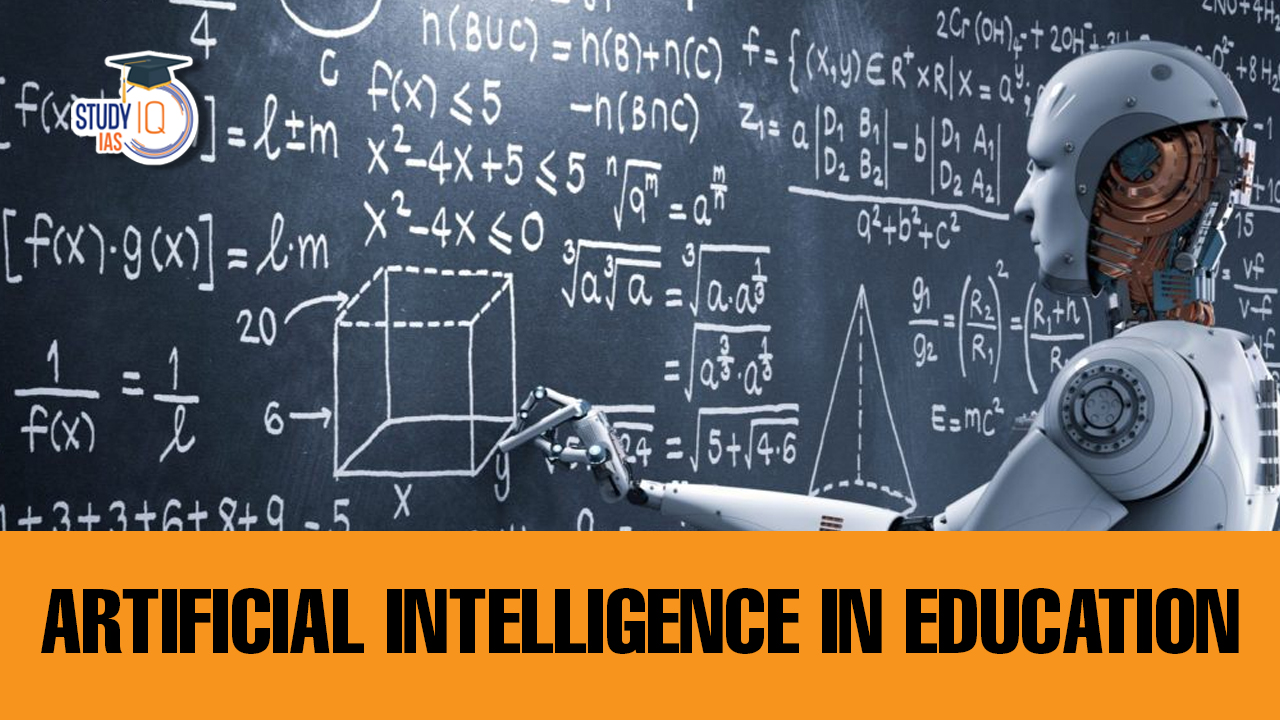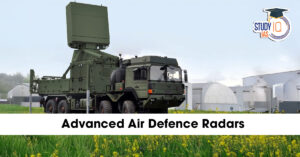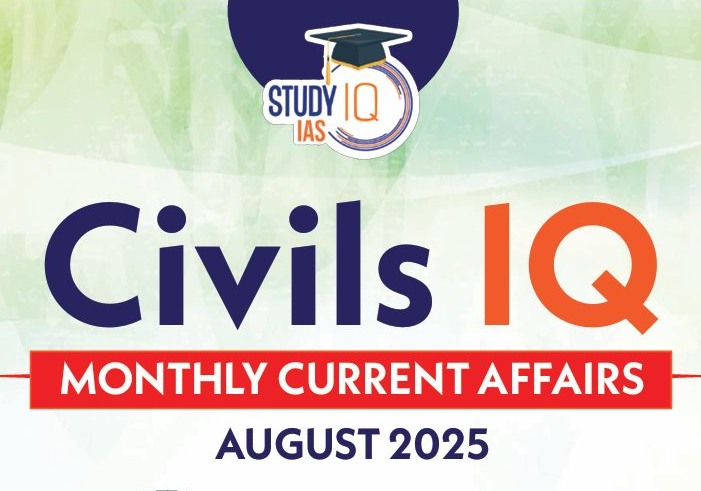Table of Contents
Context:
- The World Economic Forum2024 in Davos focused on the theme “Collaboration for the Intelligent Age”, emphasizing the integration of humanity, nature, and AI.
- In the context of education, this theme presents transformative opportunities to reshape learning by combining intelligence with consciousness.
About Artificial Intelligence
- Artificial Intelligence (AI) is a simulation of human intelligence into a computer machine so that it can think and act like a human.
- AI systems are designed to simulate or replicate human cognitive abilities, such as perception, reasoning, learning, and problem-solving.
- AI relies on algorithms and computational models to process and analyze large amounts of data, extracting patterns and making predictions or decisions based on that information.
- AI has various uses and applications in different sectors, including education.
Artificial Intelligence in Education (AIED)
- AIED refers to the application of AI technologies and techniques in the field of education.
- In the 1970s, AIED occurred as a specialist area to cover new technology in teaching & learning, specifically for higher education.
- The main aim of AIED is to facilitate learners with flexible, personalized, and engaging learning along with the basic automated task.
- Some popular trends in AIED include Intelligent tutor systems, smart classroom technologies, adaptive learning, and pedagogical agents.
AI’s Impact on Education in Current Times
- Enhanced Learning Personalization: AI tools adapt to individual student learning speeds and preferences.
- Platforms like ChatGPT, Khan Academy AI, and Duolingo AI provide tailored learning experiences.
- Automated Administrative Tasks: AI reduces the workload of teachers by automating:
- Grading
- Attendance tracking
- Administrative documentation
- Virtual Tutoring and Smart Classrooms
- AI-driven chatbots and virtual assistants help students with doubts in real time.
- Smart classrooms with AI enable interactive learning experiences.
- Early Detection of Learning Gaps: AI identifies student weaknesses through data analytics.
- Allows for targeted interventions to improve performance.
- Increased Engagement through AI-powered Content: AI-generated quizzes, simulations, and interactive lessons make learning engaging.
- Platforms like Google’s Socratic AI and Microsoft Reading Coach enhance digital learning.
Various Applications of AI in Education
- Intelligent Tutoring Systems: These systems analyze learner data, adapt the curriculum to individual needs, and offer interactive and engaging learning experiences.
- Adaptive Learning: AI algorithms analyze student performance data to create personalized learning paths. It can identify knowledge gaps, suggest appropriate learning materials, and adjust the difficulty level of content to optimize the learning process for each student.
- Automated Grading and Feedback: AI can automate the grading process for objective assessments, such as multiple-choice questions. It can also provide instant feedback to students, allowing them to identify areas for improvement and adjust their learning strategies accordingly.
- Natural Language Processing (NLP): NLP can be used in language learning applications, automated essay grading, and intelligent chatbots that provide answers to student queries.
- Intelligent Content Creation: AI can generate educational content, such as quizzes, exercises, and instructional materials.
- Virtual Reality (VR) and Augmented Reality (AR): AI technologies, combined with VR and AR, can create immersive learning environments. These technologies provide interactive simulations, virtual field trips, and 3D visualizations, enhancing understanding and engagement in various subjects.
- Data Analytics and Predictive Modeling: AI can analyze large volumes of educational data, such as student performance, attendance, and behaviour, to identify patterns and trends. Predictive models can help educators identify students at risk of falling behind and provide timely interventions.
- Intelligent Learning Management Systems (LMS): These systems can automate administrative tasks, such as scheduling and grading, allowing teachers to focus more on instruction.
Risks and Challenges with AI in Education
- Lack of AI Literacy Among Educators: Many teachers are not trained to integrate AI tools effectively.
- Concerns over AI-generated misinformation (AI hallucinations).
- Ethical and Privacy Concerns: Risk of data breaches and misuse of student information.
- Lack of clear policies on AI ethics in schools.
- Over-Reliance on AI by Students: Students using AI for homework and assignments without understanding concepts.
- Potential decline in critical thinking and creativity.
- Equity and Accessibility Issues: Unequal access to AI tools due to economic disparities.
- Rural and underprivileged students may lack digital infrastructure.
- Standardization vs. Personalization: AI-driven learning models may lack adaptability to different student needs.
- Risk of bias in AI algorithms, leading to disparities in education quality.
Challenges in the Implementation of AI in Education in India
A report by UNESCO titled ‘‘Status of Education Report 2022 for India’ ‘Artificial Intelligence (AI) in Education’ has highlighted the following challenges:
- There is a lack of policies on the role of AI in education and a lack of resources and infrastructure affects the spread of AI in education.
- There is a dearth of training data for AI in education systems in India.
Barriers to digital learning in India
- Inadequate technology infrastructure: Only around 41.3% of schools had access to computers and 24.5% to the internet in 2020-2021.
- Inability of teachers: In addition to technology infrastructure, the inability of most teachers to use technology effectively to assist their students’ learning is a significant barrier.
- Digital divide:
- Rural –urban divide: Only 68% of adolescents in urban areas were found to use technology-enabled learning tools, and only 47% in rural areas.
- Gender divide: 67 per cent of the male population is using the internet in India, while it is only 33 per cent of the female population.
- Children with disabilities, from migrant families, living in remote areas, from scheduled tribes and scheduled castes, and girls in particular experience these inequalities most acutely.
Solutions to Overcome AI Challenges in Education
- AI Training for Educators: Regular workshops and certifications on AI integration in teaching.
- Collaboration with EdTech companies to upskill teachers.
- Implementing AI Ethics and Data Privacy Policies: Strong regulatory frameworks to prevent misuse of student data.
- Transparency in AI algorithms to eliminate bias.
- Encouraging AI-Assisted Learning, Not AI-Dependent Learning: Schools must balance AI use with traditional teaching methods.
- Develop AI literacy programs to guide students on responsible AI usage.
- Bridging the Digital Divide: Government and private sector must increase AI access in rural areas.
- Affordable AI-driven learning tools for economically weaker students.
- Improving AI Adaptability in Education: AI systems should be customized for diverse learning needs.
- Developers should eliminate biases in AI algorithms to ensure fair learning outcomes.
Way Forward
Recommendations by the UNESCO Report
The report has suggested the following for the effective implementation of AI in the Indian educational system:
- AI ethics in education should be given top priority. All students and teachers should be ensured access to the latest technology.
- Providing a comprehensive regulatory framework for AI in education should be accelerated.
- Effective public-private partnerships should be created.
- Efforts should be made to remove the biases associated with algorithms and the discrimination arising out of them.
- Necessary reforms are necessary to increase public confidence in AI.
- The private sector can be consulted to better utilize the knowledge of students and academics in developing AI products.
Beijing Consensus
UNESCO has published the Beijing Consensus on Artificial Intelligence (AI) and Education, the first-ever document to offer guidance and recommendations on how best to harness AI technologies for achieving the Education 2030 Agenda.
- The Education 2030 Agenda aims to ensure inclusive and equitable quality education and promote lifelong learning opportunities for all by the year 2030, which forms a part of UN SDG 4.
The Beijing Consensus recommends that UNESCO’s Member States:
- Plan AI in education policies in response to the opportunities and challenges AI technologies bring, from a whole-government, multi-stakeholder, and inter-sectoral approach, that also allow for setting up local strategic priorities to achieve SDG 4 targets.
- Support the development of new models enabled by AI technologies for delivering education and training where the benefits clearly outweigh the risks and use AI tools to offer lifelong learning systems which enable personalized learning anytime, anywhere, for anyone.
- Consider the use of relevant data where appropriate to drive the development of evidence-based policy planning.
- Ensure AI technologies are used to empower teachers rather than replace them and develop appropriate capacity-building programmes for teachers to work alongside AI systems.
- Prepare the next generation of the existing workforce with the values and skills for life and work most relevant in the AI era.
- Promote equitable and inclusive use of AI irrespective of disability, social or economic status, ethnic or cultural background or geographical location, with a strong emphasis on gender equality, as well as ensure ethical, transparent and auditable uses of educational data.


 Advanced Air Defence Radars: Types, Comp...
Advanced Air Defence Radars: Types, Comp...
 Ion Chromatography, Working and Applicat...
Ion Chromatography, Working and Applicat...
 Broadly Neutralising Antibodies (bNAbs):...
Broadly Neutralising Antibodies (bNAbs):...




















